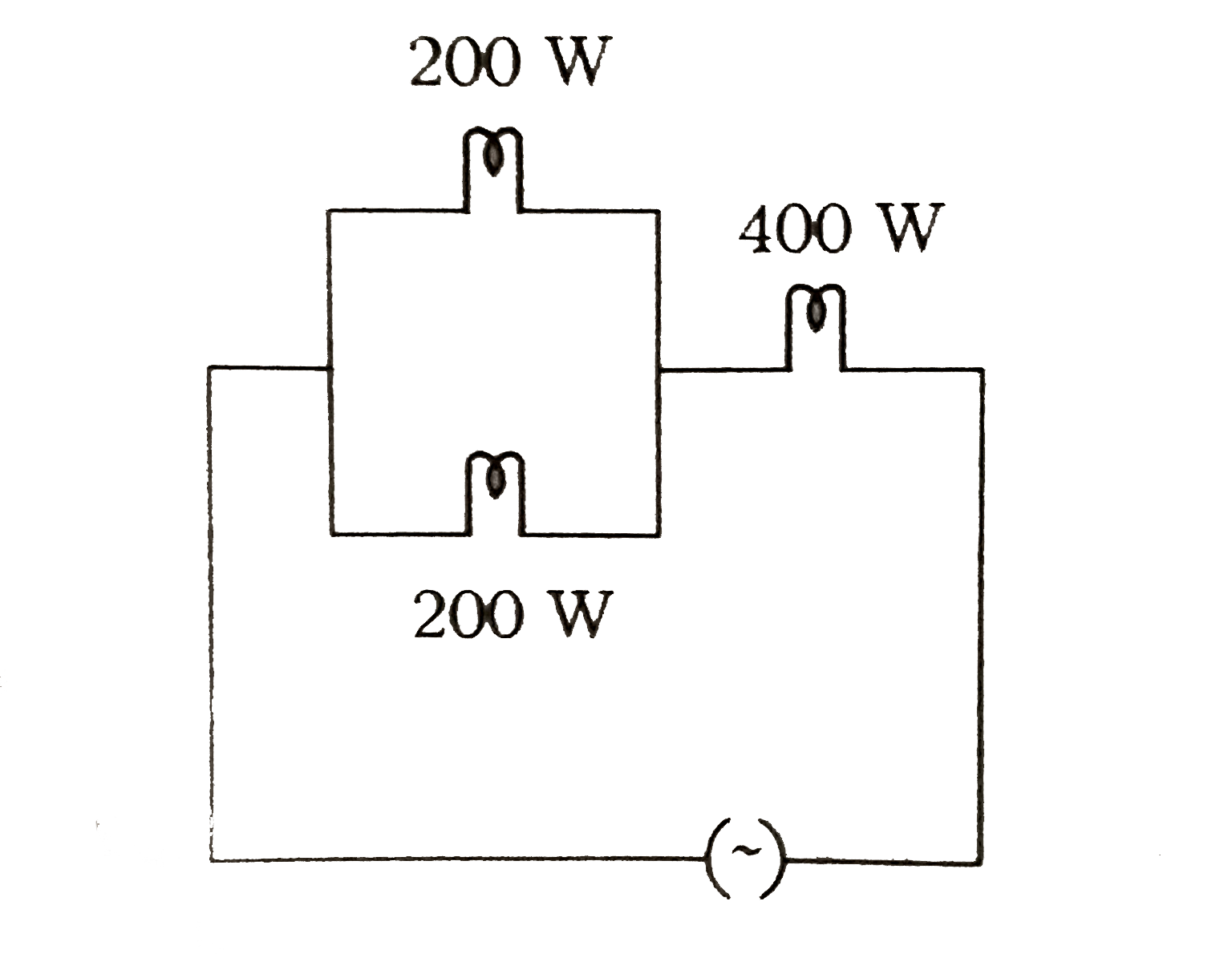There are two electric bulbs of 40W and 100W. Which one will be brighter when first connected in series and then in parallel ?
40 W in series and 100 W in parallel.
100 W in series and 40 W in parallel
40 W both in series and parallel will be uniform
100W both in series and parallel will be uniform
The correct Answer is:A
To determine which bulb will be brighter when connected in series and in parallel, we can follow these steps:
Step 1: Understand the Power Ratings
We have two electric bulbs with power ratings:
- Bulb 1: P1=40W
- Bulb 2: P2=100W
We will assume that both bulbs are rated for the same voltage V.
Step 2: Calculate the Resistance of Each Bulb
Using the formula for power:
P=V2R
We can rearrange this to find the resistance R:
R=V2P
Thus, the resistances for the two bulbs are:
- Resistance of Bulb 1:
R1=V240
- Resistance of Bulb 2:
R2=V2100
Step 3: Analyze the Series Connection
In a series connection, the same current I flows through both bulbs. The power consumed by each bulb can be expressed as:
- Power for Bulb 1:
P1=I2R1=I2(V240)
- Power for Bulb 2:
P2=I2R2=I2(V2100)
Step 4: Compare the Powers in Series
Since I2 and V2 are the same for both bulbs, we can compare the powers:
P1=I2V240,P2=I2V2100
Since 140>1100, it follows that:
P1>P2
Thus, Bulb 1 (40 W) is brighter when connected in series.
Step 5: Analyze the Parallel Connection
In a parallel connection, the voltage across both bulbs is the same. The power consumed by each bulb can be expressed as:
- Power for Bulb 1:
P1=V2R1=V2V240=40
- Power for Bulb 2:
P2=V2R2=V2V2100=100
Step 6: Compare the Powers in Parallel
Since the voltage is the same for both bulbs, we can directly compare:
P1=40,P2=100
Thus, Bulb 2 (100 W) is brighter when connected in parallel.
Conclusion
- In series, Bulb 1 (40 W) is brighter.
- In parallel, Bulb 2 (100 W) is brighter.
Final Answer
- Bulb 1 is brighter in series.
- Bulb 2 is brighter in parallel.
We have two electric bulbs with power ratings:
- Bulb 1: P1=40W
- Bulb 2: P2=100W
Using the formula for power:
P=V2R
We can rearrange this to find the resistance R:
R=V2P
Thus, the resistances for the two bulbs are:
- Resistance of Bulb 1:
R1=V240
- Resistance of Bulb 2:
R2=V2100
In a series connection, the same current I flows through both bulbs. The power consumed by each bulb can be expressed as:
- Power for Bulb 1:
P1=I2R1=I2(V240)
- Power for Bulb 2:
P2=I2R2=I2(V2100)
Since I2 and V2 are the same for both bulbs, we can compare the powers:
P1=I2V240,P2=I2V2100
Since 140>1100, it follows that:
P1>P2
Thus, Bulb 1 (40 W) is brighter when connected in series.
In a parallel connection, the voltage across both bulbs is the same. The power consumed by each bulb can be expressed as:
- Power for Bulb 1:
P1=V2R1=V2V240=40
- Power for Bulb 2:
P2=V2R2=V2V2100=100
Since the voltage is the same for both bulbs, we can directly compare:
P1=40,P2=100
Thus, Bulb 2 (100 W) is brighter when connected in parallel.
- In series, Bulb 1 (40 W) is brighter.
- In parallel, Bulb 2 (100 W) is brighter.
- Bulb 1 is brighter in series.
- Bulb 2 is brighter in parallel.
Topper's Solved these Questions
- HEATING EFFECT OF CURRENTBOOK - CENGAGE PHYSICS ENGLISHCHAPTER - HEATING EFFECT OF CURRENTEXERCISE - Thermal Power in Resistance Connected in Circuit
27 Videos
- HEATING EFFECT OF CURRENTBOOK - CENGAGE PHYSICS ENGLISHCHAPTER - HEATING EFFECT OF CURRENTEXERCISE - Integer
5 Videos
- GEOMETRICAL OPTICSBOOK - CENGAGE PHYSICS ENGLISHCHAPTER - GEOMETRICAL OPTICSEXERCISE - Integer Type
4 Videos
- INDUCTANCEBOOK - CENGAGE PHYSICS ENGLISHCHAPTER - INDUCTANCEEXERCISE - Concept Based
8 Videos
Similar Questions
When two electric bulbs of 40W and 60W are connected in parallel, then the:
View SolutionAssertion: Two electric bulbs of 50 and 100W. Are given. When connected in sereis 50W bulb glows more but when connected parallel 100 W bulb glows more.
Reason : In series combination, power is directly proportional to the resistance of circuit. but in parallel comb ination, power is inversely proportional to the resistance of the circuit.
View SolutionTwo electric bulbs (60 W and 100 W respectively) are connected in series. The current passing through them is
View SolutionTwo bulbs, when connected in series, are brighter than a single bulb.
View SolutionTwo bulbs are rated 30W−200Vand60W−200V. They are connected with a 400V power supply. Find which bulb will get fused if they are connected in (i) series and (ii) parallel.
View SolutionTwo electric bulbs one, if 200 V-40 W and other 200 V-100 W are connected in series to a 200 V line, then the potential drop across
View SolutionThree electric bulbs of 200 W, 200 W and 400 W are connected as shown in figure. The resultant power of the combination is

View SolutionThree bulbs of 40W,60Wand100W are connected in series with a 240V source.
View SolutionIf two bulbs of power 60 W and 100 W respectively each rated 110 V are connected in series with the supply of 220 V, then
View SolutionAn electric bulb is rated "220 V, 100 W'.
What is its resistance ?
View Solution
